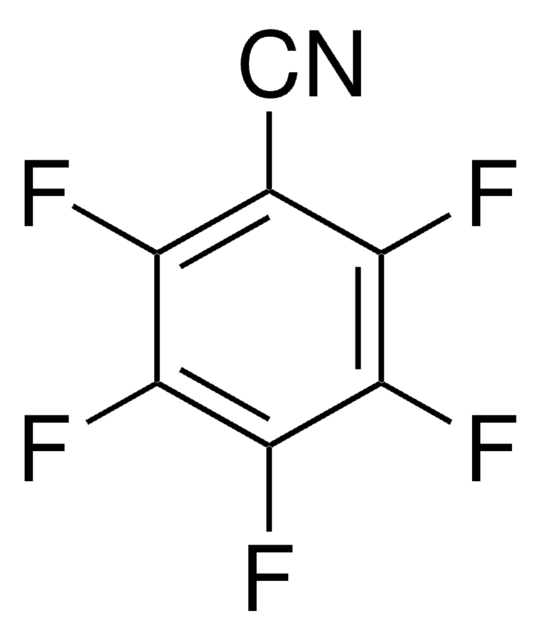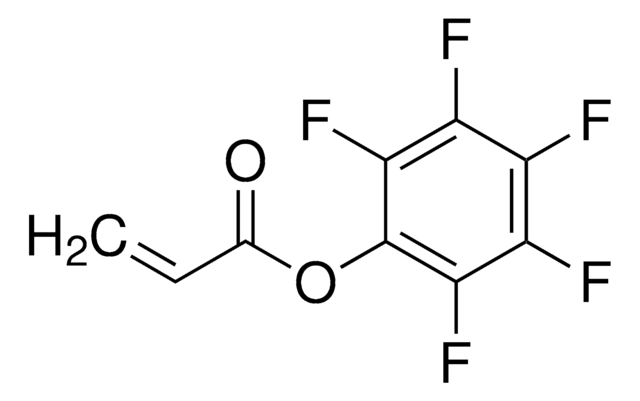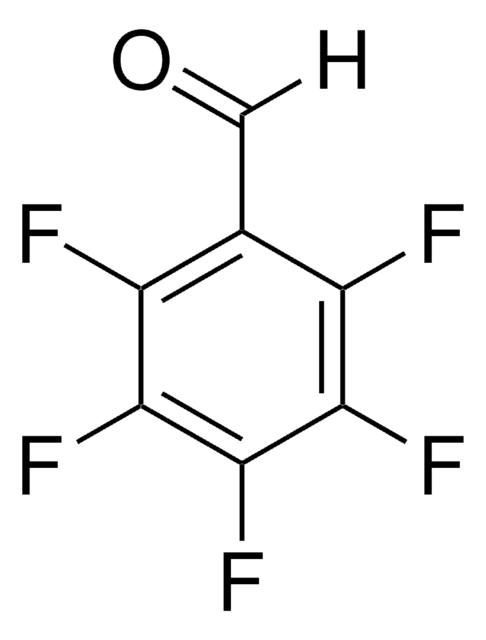All Photos(2)
About This Item
Linear Formula:
C6F5CO2CH3
CAS Number:
Molecular Weight:
226.10
MDL number:
UNSPSC Code:
12352100
PubChem Substance ID:
NACRES:
NA.22
Recommended Products
Assay
99%
form
liquid
refractive index
n20/D 1.431 (lit.)
density
1.532 g/mL at 25 °C (lit.)
SMILES string
COC(=O)c1c(F)c(F)c(F)c(F)c1F
InChI
1S/C8H3F5O2/c1-15-8(14)2-3(9)5(11)7(13)6(12)4(2)10/h1H3
InChI key
UXJRQNXHCZKHRJ-UHFFFAOYSA-N
Application
Methyl pentafluorobenzoate was used in preparation of photocoupling agent, based on perfluorophenylazide (PFPA)-conjugated polyallylamine, for efficient immobilization of polymers, nanoparticles, graphene and small molecules. It was also used in preparation of photoactive reagent N-hydroxysuccinimide (NHS)-PFPA.
Signal Word
Warning
Hazard Statements
Precautionary Statements
Hazard Classifications
Eye Irrit. 2 - Skin Irrit. 2 - STOT SE 3
Target Organs
Respiratory system
Storage Class Code
10 - Combustible liquids
WGK
WGK 3
Flash Point(F)
172.4 °F - closed cup
Flash Point(C)
78 °C - closed cup
Personal Protective Equipment
dust mask type N95 (US), Eyeshields, Gloves
Certificates of Analysis (COA)
Search for Certificates of Analysis (COA) by entering the products Lot/Batch Number. Lot and Batch Numbers can be found on a product’s label following the words ‘Lot’ or ‘Batch’.
Already Own This Product?
Find documentation for the products that you have recently purchased in the Document Library.
Customers Also Viewed
Takuya Kubo et al.
Langmuir : the ACS journal of surfaces and colloids, 27(15), 9372-9378 (2011-06-28)
A highly efficient photocoupling agent, based on perfluorophenylazide (PFPA)-conjugated polyallylamine (PAAm), was developed for the efficient immobilization of polymers, nanoparticles, graphene, and small molecules. The conjugate, PAAm-PFPA, was synthesized, and the percentage of the photoactive moiety, PFPA, can be controlled
Huibin Wang et al.
Bioconjugate chemistry, 22(1), 26-32 (2010-12-09)
A universal photochemical method has been established for the immobilization of intact carbohydrates and their analogues, and for the fabrication of carbohydrate microarrays. The method features the use of perfluorophenyl azide (PFPA)-modified substrates and the photochemical reaction of surface azido
Hiroshi Kobayashi et al.
Scientific reports, 10(1), 13850-13850 (2020-08-17)
We report on a potential method to separate sugars by using the specific interaction between fullerenes and saccharides in liquid chromatography (LC). Aromatic rings with high electron density are believed to interact strongly with saccharides due to CH-π and/or OH-π
Marllyn Marques da Silva et al.
Regulatory toxicology and pharmacology : RTP, 103, 282-291 (2019-02-23)
The fibrinolytic enzyme produced by Mucor subtilissimus UCP 1262 was obtained by solid fermentation and purified by ion exchange chromatography using DEAE-Sephadex A50. The enzyme toxicity was evaluated using mammalian cell lineages: HEK-293, J774.A1, Sarcoma-180 and PBMCs which appeared to
Na Kong et al.
Carbohydrate research, 405, 33-38 (2015-03-10)
Carbohydrate-functionalized single-walled carbon nanotubes (SWNTs) were synthesized using microwave-assisted reaction of perfluorophenyl azide with the nanotubes. The results showed that microwave radiation provides a rapid and effective means to covalently attach carbohydrates to SWNTs, producing carbohydrate-SWNT conjugates for biorecognition. The
Our team of scientists has experience in all areas of research including Life Science, Material Science, Chemical Synthesis, Chromatography, Analytical and many others.
Contact Technical Service












